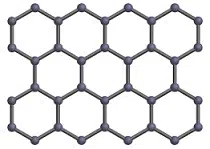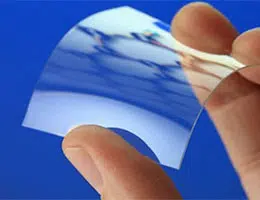 The etymology of graphene leads us to the English graphene . The term refers to a flexible and hard material obtained from graphite .
The etymology of graphene leads us to the English graphene . The term refers to a flexible and hard material obtained from graphite .
Graphene can conduct electricity and heat . Due to its characteristics, graphene can be very useful in various industrial sectors, since it is conductive, has great resistance and is light.
Composed of carbon , in this substance the atoms are organized in a hexagonal structure and linked through covalent bonds. Thanks to their studies on graphene, scientists Konstantín Novosiólovo and Andre Geim won the Nobel Prize in Physics in 2010 .
Its electrical and thermal conductivity , its flexibility and its great hardness and lightness are not the only properties valued by physicists. Graphene also has the ability to repair itself when its structure breaks (since it generates the attraction of carbon atoms close to the holes), it can withstand ionizing radiation and generates compounds with various properties through chemical reactions with other substances.
Although its applications are still under study, it is estimated that graphene can be used in water desalination via reverse osmosis , in cancer treatments and in the manufacture of touch screens, batteries and high-speed cables.
Graphene is generally distributed as graphene oxide . In any case, the difficulties in mass producing it mean that its use, at least for the moment, cannot be extended too much. It is said, therefore, that graphene is the "material of the future" since its potential is enormous.
Although in the first half of the 2010s graphene became a great promise , as mentioned in the previous paragraph, towards the beginning of the next decade everything seemed to fade away. This does not mean that it was a lie, that the material did not have the potential that scientists talked so much about at the time, but that it has not yet been possible to afford its manufacture to massify its use in different industries.
 This case is not isolated, but goes hand in hand with many other "miraculous" products or materials, which show us a window into a science fiction future, in which we will have access to incredible technologies and our daily activities will be practically automated; All of this will be possible one day, but for the moment it is only achieved in prototypes, in tests supervised by the creators and with certain limitations that prevent its introduction into the market.
This case is not isolated, but goes hand in hand with many other "miraculous" products or materials, which show us a window into a science fiction future, in which we will have access to incredible technologies and our daily activities will be practically automated; All of this will be possible one day, but for the moment it is only achieved in prototypes, in tests supervised by the creators and with certain limitations that prevent its introduction into the market.
If we only focus on the fact that graphene is made up of a sheet whose thickness is a million times smaller than that of a sheet of paper, it is not difficult to understand that its production entails certain challenges, both technically and in the economic one. To this we must add the aforementioned properties, such as its lightness: a square meter of graphene weighs only 0.77 grams.
As if all this were not enough, scientists point out that its resistance exceeds that of steel about two hundred times, an achievement that makes us think of some Marvel and DC superheroes, such as Rogue and Superman . In the field of computing, for example, it could offer an impressive increase in driving speed, since it is one hundred times faster than the silicon of microchips.
In short, graphene is truly a dream material. Perhaps scientists rushed to talk about it before having the means to mass-scale its production, or perhaps they did so with the purpose of obtaining them thanks to the response of the people and their consequent impact on the vision of investors.
